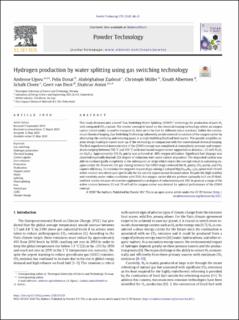| dc.contributor.author | Ugwu, Ambrose | |
| dc.contributor.author | Donat, Felix | |
| dc.contributor.author | Zaabout, Abdelghafour | |
| dc.contributor.author | Müller, Christoph | |
| dc.contributor.author | Albertsen, Knuth | |
| dc.contributor.author | Cloete, Schalk Willem Petrus | |
| dc.contributor.author | van Diest, Geert | |
| dc.contributor.author | Amini, Shahriar | |
| dc.date.accessioned | 2020-10-19T11:33:27Z | |
| dc.date.available | 2020-10-19T11:33:27Z | |
| dc.date.created | 2020-05-27T21:58:08Z | |
| dc.date.issued | 2020 | |
| dc.identifier.issn | 0032-5910 | |
| dc.identifier.uri | https://hdl.handle.net/11250/2683625 | |
| dc.description.abstract | This study demonstrates a novel “Gas Switching Water Splitting (GSWS)” technology for production of pure H2 with integrated CO2 capture. The reactor concept is based on the chemical looping technology where an oxygen carrier (metal oxide) is used to transport O2 from air to the fuel for different redox reactions. Unlike the conventional chemical looping, Gas Switching Technology inherently avoids external circulation of the oxygen carrier by alternating the oxidizing and reducing gases in a single bubbling fluidized bed reactor. This greatly simplifies reactor design leading to easier scale-up of the technology in comparison with the conventional chemical looping. The first experimental demonstration of the GSWS concept was completed at atmospheric pressure and temperatures ranging between 700 °C and 900 °C with iron-based oxygen carrier supported on alumina (~35 wt% Fe2O3 on Al2O3). Approximately 99% H2 purity was achieved at ~80% oxygen utilization. Significant fuel slippage was observed especially beyond 33% degree of reduction with some carbon deposition. The deposited carbon was able to combust/gasify completely in the subsequent air stage which makes the concept robust in sustaining oxygen carrier life. However, the gas mixing between the GSWS stages reduced the H2 purity, CO2 purity, and CO2 capture efficiency. To minimize the negative impact of gas mixing, Cu doped Mg(Fe0.9Al0.1)2O4 spinel with 74 wt% active content was developed specifically for the second experimental demonstration. Despite the high stability and reactivity under redox conditions with TGA, this oxygen carrier did not perform optimally in 5 cm ID fluidized bed reactor because of excessive agglomeration at degree of reduction beyond 34%. In general, a range of the active content between 35 and 70 wt% of the oxygen carrier was desired for optimal performance of the GSWS concept. | en_US |
| dc.language.iso | eng | en_US |
| dc.publisher | Elsevier | en_US |
| dc.rights | Navngivelse 4.0 Internasjonal | * |
| dc.rights.uri | http://creativecommons.org/licenses/by/4.0/deed.no | * |
| dc.subject | Gas switching | en_US |
| dc.subject | Hydrogen production | en_US |
| dc.subject | Chemical looping | en_US |
| dc.subject | Carbon captureZero-emission | en_US |
| dc.subject | Fluidization | en_US |
| dc.subject | Production | en_US |
| dc.subject | Watersplitting | en_US |
| dc.subject | cGHG | en_US |
| dc.subject | Natural gas | en_US |
| dc.subject | Climate change | en_US |
| dc.title | Hydrogen production by water splitting using gas switching technology | en_US |
| dc.type | Peer reviewed | en_US |
| dc.type | Journal article | en_US |
| dc.description.version | publishedVersion | en_US |
| dc.rights.holder | Copyright 2020 The Authors | en_US |
| dc.source.pagenumber | 48-63 | en_US |
| dc.source.volume | 370 | en_US |
| dc.source.journal | Powder Technology | en_US |
| dc.identifier.doi | https://doi.org/10.1016/j.powtec.2020.05.039 | |
| dc.identifier.cristin | 1812934 | |
| dc.relation.project | Norges forskningsråd: 271511 | en_US |
| dc.relation.project | EC/H2020/691712 | en_US |
| cristin.ispublished | true | |
| cristin.fulltext | postprint | |
| cristin.qualitycode | 1 | |

